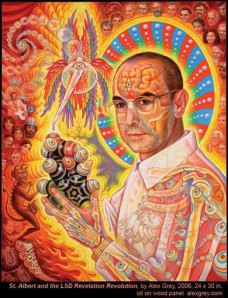Albert Hofmann, the Swiss chemist who discovered the hallucinogenic drug LSD, has died of a heart attack at his home in Basel at the age of 102.
“I think that in human evolution it has never been as necessary to have this substance LSD,” he said at a symposium in 2006, marking the centennial of his birth. “It is just a tool to turn us into what we are supposed to be.”
Albert Hofmann was a synthetic chemist with Sandoz Laboratories, now Novartis, in Switzerland when in 1943 he stumbled on the hallucinatory effects of LSD. After it became seen by Harvard’s Timothy Leary and others in the ’60s as a pathway to spiritual enlightenment, and then as a major recreational drug, “Instead of a ‘wonder child,’ LSD suddenly became my ‘problem child,’ ” Hofmann said.
LSD and the other psychoactive drugs “changed my life, insofar as they provided me with a new concept about what reality is,” he said. “Before, I had believed there was only one reality: the reality of everyday life.
“Under LSD, however, I entered into realities which were as real and even more real than the one of everyday.” He also “became aware of the wonder of creation, the magnificence of nature and of the plant and animal kingdom. I became very sensitive to what will happen to all this and all of us.”
After dozens of acid trips, Hofmann finally gave up psychedelics. “I know LSD; I don’t need to take it anymore,” he said.
Hofmann is survived by his wife, Anita; two daughters; a son;eight grandchildren; and six great-grandchildren.
By Thomas H. Maugh II, Los Angeles Times Staff Writer
April 30, 2008
“Through my LSD experience and my new picture of reality, I became aware of the wonder of creation, the magnificence of nature and of the animal and plant kingdom,” Dr. Hofmann told the psychiatrist Stanislav Grof during an interview in 1984. “I became very sensitive to what will happen to all this and all of us.”
Dr. Hofmann became an impassioned advocate for the environment and argued that LSD, could be used to awaken a deeper awareness of mankind’s place in nature and help curb society’s ultimately self-destructive degradation of the natural world.
But he was also disturbed by the cavalier use of LSD as a drug for entertainment, arguing that it should be treated in the way that primitive societies treat psychoactive sacred plants, which are ingested with care and spiritual intent.
After his discovery of LSD’s properties, Dr. Hofmann spent years researching sacred plants. With his friend R. Gordon Wasson, he participated in psychedelic rituals with Mazatec shamans in southern Mexico. He succeeded in synthesizing the active compounds in the Psilocybe mexicana mushroom, which he named psilocybin and psilocin. He also isolated the active compound in morning glory seeds, which the Mazatec also used as an intoxicant, and found that its chemical structure was close to that of LSD.
Some links on the story including video clips;



